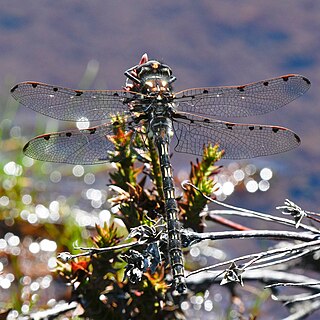
Austrogynacantha is a genus of dragonfly in the family Aeshnidae. Austrogynacantha heterogena, commonly known as the Australian duskhawker, is the only known species of this genus which is found in Australia and New Caledonia.

Austrogomphus prasinus, also known as Austrogomphus (Pleiogomphus) prasinus, is a species of dragonfly of the family Gomphidae, commonly known as the lemon-tipped hunter. It inhabits streams and rivers in northern Queensland, Australia.

Austrogomphus bifurcatus, also known as Austrogomphus (Pleiogomphus) bifurcatus, is a species of dragonfly of the family Gomphidae, commonly known as the dark hunter. It inhabits streams and rivers in northern Queensland, Australia.

Austrogomphus doddi, also known as Austrogomphus (Austrogomphus) doddi, is a species of dragonfly of the family Gomphidae, commonly known as the northern river hunter. It inhabits streams and rivers in north-eastern Queensland, Australia.

Cordulephya divergens is a species of dragonfly of the family Cordulephyidae, commonly known as the clubbed shutwing. It inhabits streams in the Sydney Basin, Australia.

Archipetalia is a monotypic genus of Australian dragonflies in the family Austropetaliidae, The only known species of this genus is Archipetalia auriculata, known as a Tasmanian redspot.

Archaeosynthemis spiniger is a species of dragonfly of the family Synthemistidae, known as the spiny tigertail. It is a medium-sized dragonfly with black and yellow markings. It inhabits streams and rivers in south-western Australia.

Archaeosynthemis occidentalis is a species of dragonfly of the family Synthemistidae, known as the western brown tigertail. It is a medium-sized dragonfly with reddish-brown and yellow markings. It is endemic to south-western Australia where it inhabits boggy creeks and swamps.

Eusynthemis aurolineata is a species of dragonfly of the family Synthemistidae, known as the variable tigertail. It is a medium-sized dragonfly with black and yellow markings. It inhabits mountain swamps and streams in eastern Australia

Eusynthemis nigra is a species of dragonfly of the family Synthemistidae, known as the black tigertail. It is a medium-sized dragonfly with black and yellow markings. It inhabits streams in eastern Australia

Notoaeschna geminata is a species of dragonfly in the family Telephlebiidae, known as the northern riffle darner. It is endemic to eastern Australia, occurring north of the Hunter River, New South Wales, where it inhabits rapid streams.

Spinaeschna watsoni is a species of dragonfly in the family Telephlebiidae, known as the tropical cascade darner. It is a medium to large, dark brown dragonfly with greenish-yellow markings. It is endemic to north-eastern Australia, where it inhabits streams and rivers.

Telephlebia brevicauda is a species of dragonfly in the family Telephlebiidae, known as the southern evening darner. It is a medium to large, dark chestnut brown dragonfly with dark markings on the leading edge of its wings. It is endemic to eastern Australia, occurring in alpine New South Wales and Victoria, where it inhabits boggy areas, and flies at dusk.

Telephlebia tryoni is a species of dragonfly in the family Telephlebiidae, known as the coastal evening darner. It is a medium to large, dark chestnut brown dragonfly with dark markings on the leading edge and base of its wings. It is endemic to eastern Australia, where it has been found along streams in rainforests and open areas, and flies at dusk.

Dendroaeschna is a monotypic genus of Australian dragonflies in the family Brachytronidae. The only known species of this genus is Dendroaeschna conspersa, commonly known as a wide-faced darner.

Austrophya mystica, known as a rainforest mystic, is a species of dragonfly in the family Austrocorduliidae, endemic to north-eastern Australia.

Pseudocordulia is a small genus of dragonflies that are endemic to tropical northeastern Australia. They are medium-sized, bronze-black dragonflies with clear wings. Its taxonomic placement has varied, with some authors placing it in the monotypic family Pseudocorduliidae, while others include it in Corduliidae or Synthemistidae.

Pseudocordulia elliptica is a species of dragonfly in the family Pseudocorduliidae, known as the ellipse-tipped mistfly. It is a medium-sized, bronze-black dragonfly with clear wings. It is endemic to north-eastern Queensland, Australia, where it inhabits rainforest streams.

Archibasis mimetes is a species of damselfly in the family Coenagrionidae, commonly known as a blue-banded longtail. It is a medium-sized damselfly; the male is bright blue and black. It has been recorded from New Guinea and northern Australia, where it inhabits streams.

Indolestes alleni is a species of damselfly in the family Lestidae, commonly known as a small reedling. It is found across northern Australia where it inhabits lagoons, ponds and swamps.























